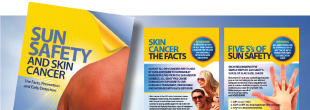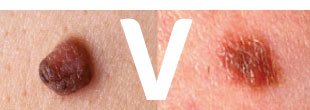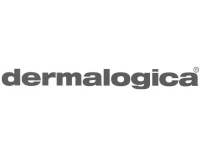
RAISING AWARENESS THROUGH EDUCATION
PROMOTING PREVENTION & EARLY DETECTION CAMPAIGNING FOR CHANGE
SKCIN: THE KAREN CLIFFORD SKIN CANCER CHARITY / REGISTERED CHARITY: 1150048

WE NEED YOUR HELP! PLEASE HELP US TO STOP SKIN CANCER TAKING MORE LIVES. WE ARE HUGELY GRATEFUL FOR YOUR SUPPORT.
How to Spot Skin Cancer
Sun Safety & Prevention
Over 80% of all skin cancers are preventable by following
just 5 simple sun safe measures: Slip, Slop, Slap, Slide, Shade...

A child’s delicate skin can burn within minutes causing
irreparable damage - learn how to protect them...

Do you know your facts about Sunscreen? Which to buy, what
SPF, UVA protection, how much to apply, when to reapply...

Did you know that the snow reflects up to 80% of sun
burning UV radiation! Learn about winter sun protection...

Is your child’s school or pre-school Sun Safe?
Make sure children are protected during school hours...

Do you work outdoors? Is your workplace Sun Safe?
Find out more about Sun Safety in the Workplace...
The importance of early detection
The early detection of skin cancer is vital and can reduce a patients risk of disfigurement through removal, or in the most serious of cases death. It is therefore very important to get to know your own skin so that you can recognise any signs of change that may be a potential skin cancer or pre cancerous skin legion.
Please be aware that it is important to check your skin both thoroughly and regularly (experts suggest at least once a month) to ensure you identify abnormal changes as early as possible.
It is also important to seek immediate professional advice from your GP or skin specialist / dermatologist should you be concerned or uncertain about anything you identify.
Click here for guidance on how to check your skin properly >
There are two main types of skin cancer, Non-Melanoma skin cancers (NMSC) and Melanoma skin cancer, which is the most serious type of skin cancer. Below you will find examples of each of the various forms of skin cancer within these categories, with tips and symptoms to help you understand what you should be looking for when checking your skin.
Further in-depth information on all types of skin cancer including: signs, symptoms, causes and risk factors, treatments and prevention guidelines can be found in the 'Types of Skin Cancer' section.


Basal Cell Carcinoma
Basal Cell Carcinoma (BCC) is the most common type of skin cancer. It grows slowly over months and years and may damage nearby tissues and organs if left untreated.
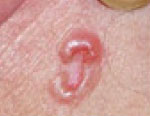
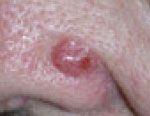
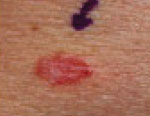
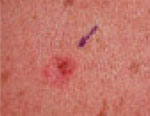
There are five warning signs that indicate the possibility of Basal Cell Carcinoma.
However, often two or more of the five warning signs can be present in a single site.
Some of these warning signs can resemble non-cancerous skin conditions such as eczema or psoriasis, it is therefore important to have any abnormalities checked by a skin specialist.
All images used are to help you identify any abnormalities, but all skin cancers can vary in size shape and colour, and many can be very small, so it is important to acknowledge that these should be used as a guideline only. If you notice any of the following warning signs, feel worried or unsure about any change in your skin, consult your doctor immediately.

1: An open, non-healing sore
This is a common warning sign of an early Basal Cell Carcinoma
A persistent sore that oozes, bleeds, crusts for weeks
The sore sometimes heals, but re-opens

2: A pinkish growth
Growths often have an elevated, rounded border
They may or may not have a crusted indentation to the centre
As the growth enlarges, tiny blood vessels can appear on the surface

3: Red patch or irritated area of skin
Sometimes patches can crust and itch
They can persist with no evident discomfort
They frequently occur on the face, shoulders, chest, legs and arms

4: A shiny Nodule or bump
These are often pearly or translucent
They can also appear pink, red or white
On darker skinned individuals they can be tan, brown or black

5: A scar-like patch
The area looks like a scar with undefined borders
The scar-like area often looks white, yellow and is waxy
This could indicate an invasive BCC that is much larger than it appears from the surface


Squamous Cell Carcinoma
Squamous Cell Carcinoma (SCC) is less common but grows faster. It may spread to other parts of the body and if left untreated can be deadly.
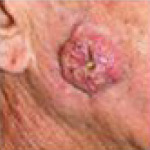
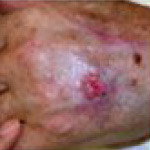
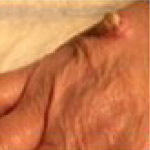
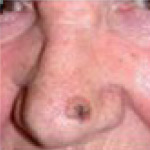
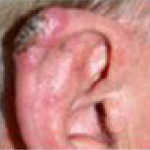
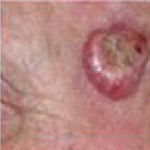
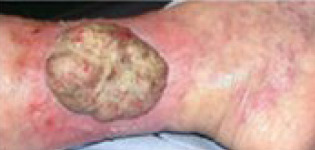
- SCC is usually found on areas of skin often exposed to the sun, typically the face, ears, lips, mouth, hands, arms and legs but can appear anywhere on the body.
- The appearance varies but is usually a scaly lump, nodule, ulcer or non-healing sore or wart that is elevated with a central depression and may crust and bleed.
- They often start as small hard white or skin-coloured lumps in the skin that grow at a variable rate.
Below are 4 warning signs that indicate the possibility of Squamous cell Carcinoma
Sometimes two or more of these warning signs can be present in a single site. All images used here are to help you identify any abnormalities, but all skin cancers can vary in size shape and colour and texture, so it is important to acknowledge that these should be used as a guideline only. If you notice any of the following warning signs, feel worried or unsure about any change in your skin, consult your doctor immediately.

1: A persistent Scaly patch
Often red in colour, with uneven borders
Look out for a scaly patch of skin that won't heal
Often these patches will crust and bleed

2: An elevated growth with central depression
Growths are raised with an indentation to the centre
Growths can sometimes bleed
They can grow rapidly in size

3: Open sore
Look out for an open sore-like wound
A sore that constantly crusts and bleeds
A persistent sore that won't heal over weeks

4: A wart-like growth
Look out for a growth that resembles a wart
A growth that crusts and sometimes bleeds
A wart-like growth that won't heal or respond to treatment


Melanoma
Melanoma is the least common but most dangerous type of skin cancer. It is often fast growing and can spread to other parts of the body to form a new cancer.
Checking your skin thoroughly for any signs of change at least once a month, is very important for the early detection of any skin cancer.
However, when it comes to melanoma, which can be fatal if not detected early enough it is absolutely vital that you know your skin, know what signs to look for and seek professional medical advice with ANYTHING you feel uncertain of or are worried about!
If you go to your GP, to be told that your concern is nothing to worry about, but your are still unsure and worried, it is important to request a referral for expert advice from a trained skin specialist. GP's who are not trained sufficiently can and do miss melanomas - so make sure you seek professional advice and/or have a full screening to eliminate any risks and uncertainty.
To help you remember and recognise the major warning signs of melanoma, the most commonly used strategy is: 'The ABCDE of Melanoma' (although the same strategy should be used for the detection of Nodular Melanoma). Use the information below to help you know what to look for when checking your skin - However, it is important to acknowledge that all melanomas can differ considerably in size, shape and colour, so the images used here are to be used as a guideline only. It is also important to acknowledge that these are close-up images and that if located early enough they can appear very small on the body. It is therefore a good idea to use a magnifying glass to help you check smaller potential abnormalities.
Information on how to check your skin properly can be found here > How to check your skin -
but essentially you need to make sure you check EVERYWHERE and get someone to help check hard to see places.
The ABCDE of Melanoma:
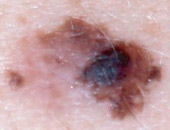
When one half of the mole does not match the other half
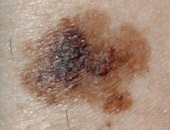
When the borders of the mole are irregular, ragged or blurred
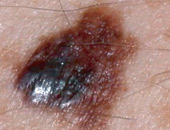
When the colour of the mole varies throughout / no uniform pigmentation
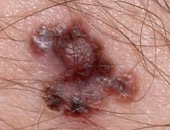
When the diameter is greater than 6mm (but it could be smaller)
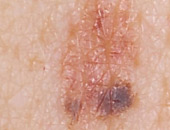
Changes in the mole over variable time - weeks, months or years

WARNING
Nodular Melanomas do not typically follow these guidelines - see below for guidance
You should consult your doctor if you develop any of the following signs:
- Changing shape, particularly getting an irregular outline.
- Changing colour/getting darker, becoming patchy or multi-shaded.
- An existing mole getting bigger or a new mole growing quickly.
- A mole starts to itch, becomes painful, starts bleeding, becomes crusty or inflamed.
How to detect Nodular Melanoma:
Nodular melanomas do not follow the ABCDE of Melanoma outlined above.
They are more even in colour and have even edges.
They grow fast, downward and become quickly invasive (within months!).
A good way to remember what to look out for is EFG:
E = ELEVATED, F = FIRM TO TOUCH, G = GROWING
Nodular melanomas are usually black, but occasionally are blue, grey, white, brown, tan, red or skin tone. The images below show some examples, but if you detect any lump on the skin that is growing quickly - seek professional medical advice immediately.
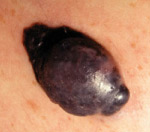
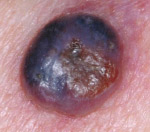
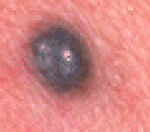

Examples of Arcal Lentiginous Melanoma
Unlike other melanomas Arcal Lentiginous Melanoma is usually located on the palms of hands, soles of feet and under nails and appears as a black discolouration.
This type of melanoma is more common in Asians and African-Americans and less common among Caucasians and can advance faster than Lentigo Maligna and Superficial Spreading Melanoma.
These are examples of Arcal Lentiginous Melanoma:
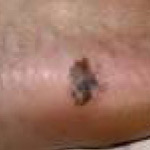
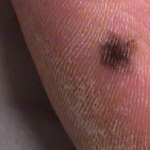
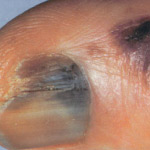
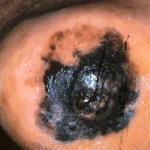


Actinic Keratosis
Actinic Keratosis (AK) is also known as Solar Keratosis caused by UV radiation, is the most common precancer which can advance to Squamous Cell Carcinoma.
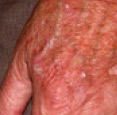
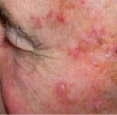
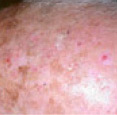
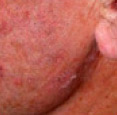
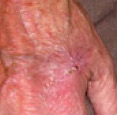
- Usually actinic keratoses appear as scaly or crusty growths that are small, single or multiple rough spots smaller than 1cm in diameter.
- Most become red, but some will be light or dark tan, pink, red, a combination of these, or can be the same colour as your skin.
- They typically present on sun-exposed sites such as the face, scalp, hands and arms
- Actinic Keratoses frequently start so small that they are recognised by touch rather than sight.
- They feel rough (like running your fingers over sand paper) and can cause soreness, irritation, discomfort or pain or they may just pose a cosmetic nuisance.
- You'll most often see the plural, "Keratoses," because there is seldom just one.
- There are many times the number of invisible (subclinical) lesions as visible ones on the skin surface.
- Most often, Actinic Keratoses develop slowly and reach a size from an eighth to a quarter of an inch.
- Early on, these patches may disappear only to reappear later.
- Occasionally they itch or produce a pricking or tender sensation.
- They can also become inflamed and surrounded by redness.
- In rare instances, Actinic Keratoses can even bleed.
- Actinic keratosis is a precancer which indicates sun damage and can lead to Squamous Cell Carcinoma which if left untreated has the potential to spread to organs and be fatal.


Intra-Epidermal Carcinoma (Bowen's Disease)
Bowen's Disease is a precancerous skin lesion that has not yet penetrated the basement membrane, but can if left untreated, lead to Squamous Cell Carcinoma.
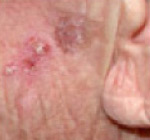
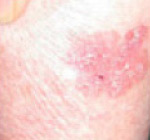
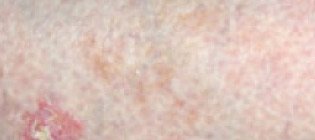
- A patch of Bowen's disease starts as a small red scaly area, which grows very slowly.
- Often there are no symptoms, although the surface may catch on clothing.
- It may reach a diameter of a few centimetres across.
- It commonly occurs on sun-exposed skin, especially the face, scalp and neck, as well as the hands and lower legs, but can occur anywhere. More than one area may be present.
- Bowen's disease typically presents as an asymptomatic, slow growing, sharply-demarcated, scaly red, pink, salmon coloured patch or plaque. The border may be irregular.
- The surface may be flat, scaly, crusted, eroded, ulcerated, velvety or verrucous [warty].
The development of an ulcer or lump on a patch of Bowen's disease may indicate the formation of invasive squamous cell cancer, so it is very important to seek professional advice with anything suspicious.

out the truth and misconceptions
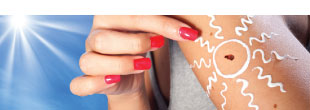
what you should be looking for...
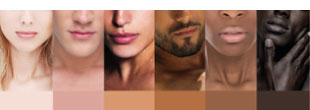
of associated risk and protection...

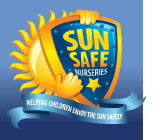
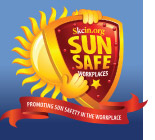

Articles of interest
SIG ROOFING PARTNERS WITH SKCIN
Aptly timed during skin cancer awareness month, National roofing merchant SIG Roofing has announ...
28th May 2024 3:05pm
SKCIN, a charity that specialises in the prevention and early detection of skin cancer through educational interve...
1st May 2024 12:39pm
AHEAD OF NATIONAL SKIN CANCER AWARENESS MONTH IN MAY, BRITISH BEAUTY BACKS VAT BURN CAMPAIGN AMIDST SKIN CANC...
26th Apr 2024 2:16pm
SUNAK WARNED MELANOMA CASES WILL INCREASE WITHOUT GOVERNMENT ACTION
Skcin are proud to support SNP MP Amy Callaghan with her on-going VAT Burn Campaign as she...
28th Nov 2023 12:20pm
SKCIN are delighted to highlight a positive initiative by New College Lanarkshire in Motherwell. The college is supporti...
22nd Jun 2023 1:05pm
